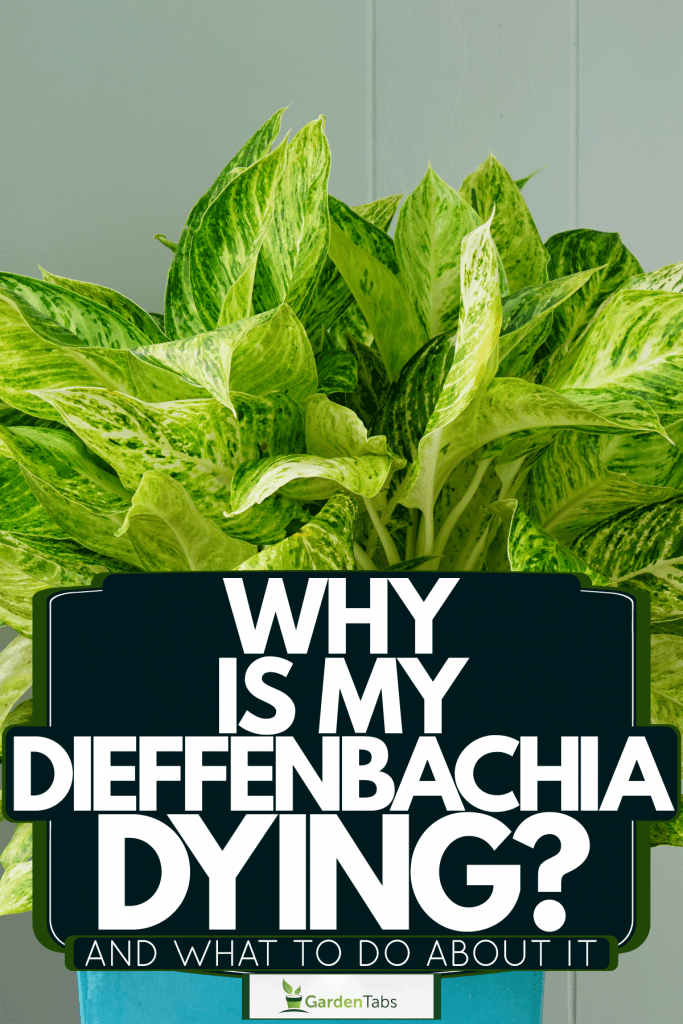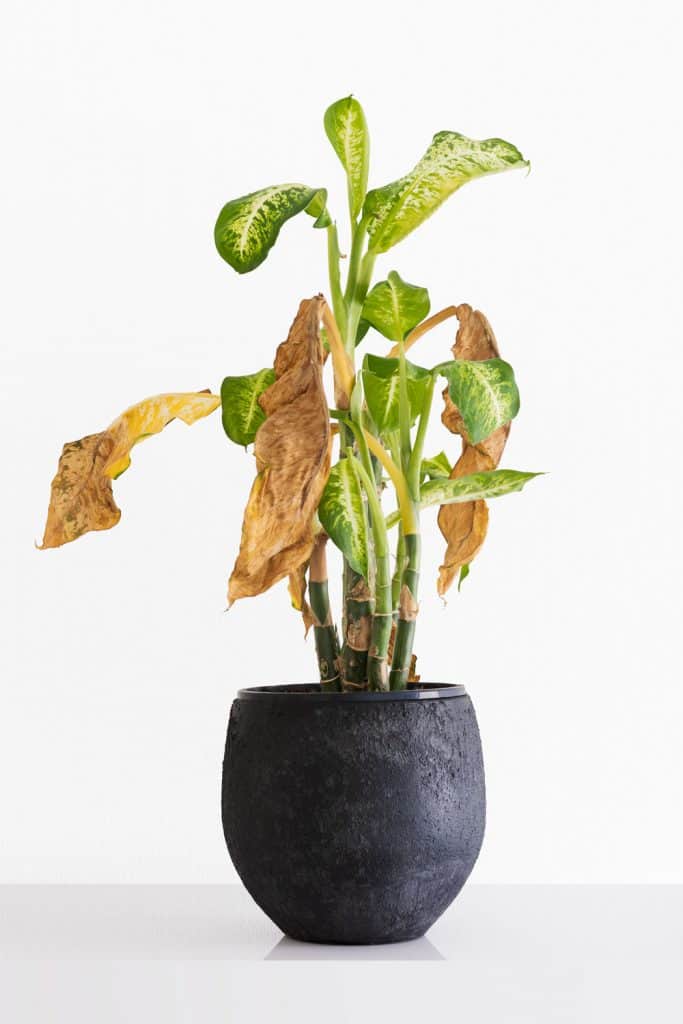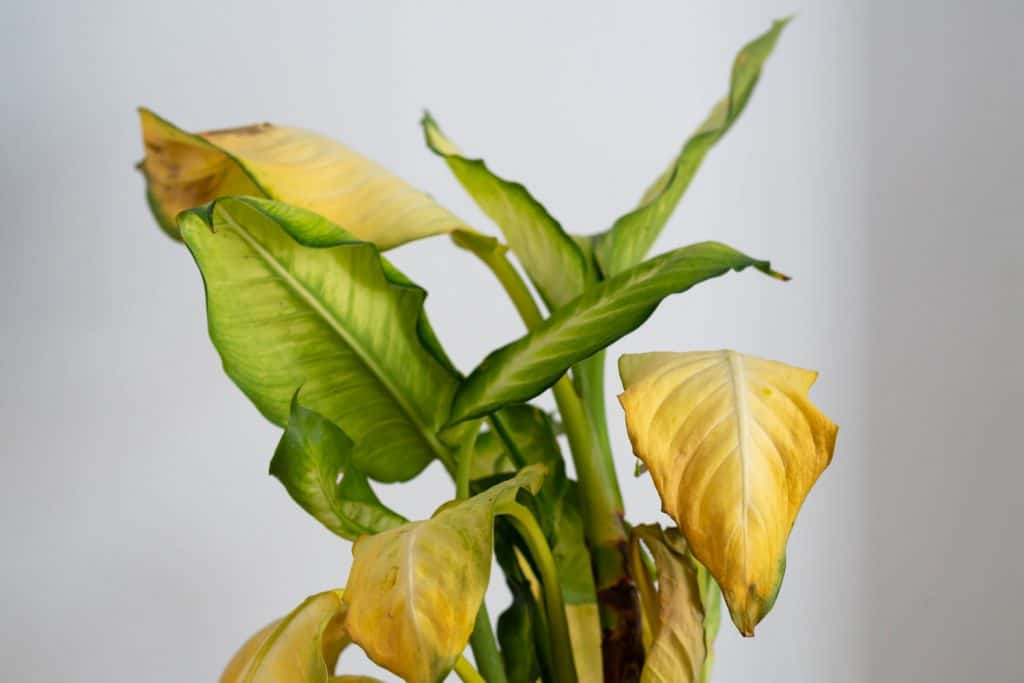Dieffenbachia is a relatively easy plant to grow, so if you've noticed yours isn't looking in the best shape, you may be wondering why. Well, we've researched in-depth why your dieffenbachia might be dying and what you can do about it. Check out some reasons below!
Your dieffenbachia might be dying because of the following:
- Too much sunlight
- Overwatering
- Underwatering
- Being kept at an incorrect temperature
- Lack of nutrients from fertilizer
- The pot the plant is in
- Pests
Now that we've given you some reasons your dieffenbachia might be dying, keep reading as we discuss each one further and what you can do about it. We'll also answer some other questions you might have about dieffenbachia plants.

Contents
Reasons Your Dieffenbachia Might Be Dying
There are several reasons your dieffenbachia might be dying. However, most of them result from the way the plant is being cared for. Let's go over each reason, how you can identify the problem, and how to fix it.

Too Much Sunlight
Dieffenbachia plants do not like to be kept in full sun, and while they tolerate full shade, this is also not preferable. For the best growing environment, dieffenbachia should be kept in partial shade or spotted sunlight. It should also be fine in bright areas as long as the plant isn't receiving direct sunlight.
Direct sunlight may scorch the plant's leaves. If your plant is sitting by a window with the sun shining on it, this might be why it's dying. Try moving it to a different spot.
It's also important to consider that the plant's location might be ideal for one or two seasons, but you might have to move it around when fall or winter arrives.
Overwatering
Plants need water to survive, but giving them too much can cause more harm than good. If you've noticed the edge of your dieffenbachia's leaves begin to turn brown, overwatering is the likely cause. Overwatering your plant can lead to several diseases. So, if you're watering it too often, you might be killing your dieffenbachia plant.
The soil of your dieffenbachia shouldn't be too moist. When you think it might need some water, feel the top 1 to 2 inches of soil. If it's dry, it's time to water your plant.
Underwatering
Like you can overwater a plant, you can also underwater a plant. Dieffenbachia plants are no exception. If you've noticed your dieffenbachia's leaves begin to droop, you may be underwatering your plant. You should keep the soil of your plant damp but not too moist.
Follow our directions for watering your dieffenbachia in the previous section, but remember no more than the top 2 inches of soil should be dry. If it's dry further down than this, you should water your plant more often.
Incorrect Temperatures
Dieffenbachia is a tropical plant, so that it will do well in warmer areas of your home. If kept too cold, your dieffenbachia will begin to drop leaves. The ideal climate for your dieffenbachia plant is warm and humid.
Ideally, the temperature should be between 65-75 degrees Fahrenheit. Anything less than this is too cold and might stunt the growth of your plant.
Lack of Nutrients
If your dieffenbachia plant's leaves have begun to yellow, it may be due to a lack of nutrients. Dieffenbachia should be given fertilizer to help them grow. Dieffenbachia should receive a 20-20-20 fertilizer every 4 to 6 weeks. If you haven't been feeding your dieffenbachia plant, this might be why it is dying. Try giving it some nutrients to see if it perks up!
Click here to see 20-20-20 fertilizer on Amazon.
The Plant's Pot
Dieffenbachia's need room to grow. Choosing the correct pot size might not have seemed like too big of a deal, but dieffenbachias have an extensive root system. If you can see the roots growing out of the bottom of your pot's drain holes, it's time to repot the plant in a bigger pot. Try to choose a pot that is a few inches bigger than the previous pot.
Pests
Houseplants, just like any garden plant, can also be susceptible to a pest infestation. Dieffenbachia plants can be infested by spider mites, mealybugs, and aphids. You can determine if your dieffenbachia has been infested by checking under its leaves. Each pest can be identified simply by taking a look.
If you know small white dots, it's likely spider mites. Mealybugs give the appearance of cotton while grouped in colonies. Finally, aphids often look like tiny green bugs and will suck the sap out of your plant, leaving a sticky residue behind.
Other symptoms of a pest infestation include droopy or wilted-looking leaves. If your plant becomes infested with one of these pests, you should treat it right away. Most pests can be washed off the plant with soap, but more resilient pests might require insecticidal soap.
Click here to see insecticidal soap on Amazon.
How often should you water a dieffenbachia?
So we've talked about how overwatering and underwatering your dieffenbachia can lead to problems, so just how often should you water your plant?
Well, you should water your dieffenbachia's soil around once a week. Just be sure to let the top inch of soil get dry before watering it again, or you made end up with an overwatered plant. Overwatering your plant can lead to several problems that we talked about earlier in the post.
Why is my dieffenbachia not growing?
To most plant owners, houseplants might as well be their children. We love, feed, and take care of them, and we want them to grow well and healthily. So, if your dieffenbachia has seemed to stall in its growth, you may be wondering why. There are a few reasons your dieffenbachia might not be growing.
A dieffenbachia's growth might be stunted if it's not being kept in a warm or sunny enough environment. It may also stop growing if it isn't receiving enough nutrients. Finally, stunted leaf growth may be a sign of a pest infestation. You can head back to a few sections in this post for tips on how to help your plant survive any of these problems.
Dieffenbachia and Their Leaves
You can often tell a plant's health by taking a look at its leaves. Leaves change colors, shape and sometimes fall off if a plant isn't healthy. So, let's go over some questions you might have about your dieffenbachia leaves.
Should you cut off brown dieffenbachia leaves?
Brown dieffenbachia leaves can be removed from your plant. You can also remove any leaves that have yellowed or died. However, you should only remove the entire leaf if most of it is damaged, say over 50%. You should cut the leaf off all the way to the main stem. If your leaf has brown edges, you can prune the ends of the leaf to remove it.
Why are the leaves on my dieffenbachia plant turning yellow?

First of all, you should rule out any natural yellowing of the leaves. Dieffenbachia leaves often begin to yellow around fall or winter. If you're sure the yellow leaves result from an issue with the plant, then it's time to consider the causes. The most likely reason the leaves on your dieffenbachia plant are turning yellow is overwatering or underwatering.
However, yellow leaves can also indicate environmental issues like a lack of sunlight, humidity, or temperature. Dieffenbachia plants like bright, warm, and humid areas away from direct sunlight.
Will dieffenbachia leaves grow back?
Dieffenbachia leaves that have fallen from the bottom of the plant will not grow back. It's natural for the plant to drop leaves as it grows, but your plant shouldn't be losing them consistently and in a large number. New growth comes from the top of the plant, so, unfortunately, you won't see those bottom leaves come back.
If you don't like the look of the bare cane at the bottom, you can try cutting off the top of the plant and regrowing it. Propagating dieffenbachias can be done and is relatively easy. This might be the only solution if you dislike how the bare cane looks.
Check out this video for guidance on propagating a dieffenbachia:
Final Thoughts
There are many reasons your dieffenbachia might be suffering. Hopefully, our article has helped you figure out which one might be causing your dieffenbachia plant to die. Fortunately, dieffenbachias are pretty hardy plants, so you should be able to nurse it back to health. If not, you can try propagating your plant to grow a new one! Good Luck!
For more reading, check out some of our related posts below:
11 Low Maintenance Indoor Trees To Consider



Hi, mine the base leaves of my dumb cane keeps turning yellow. Not the leaf edge but the white/light green part of the leaves and the yellowing spreads to the whole leaf! I v lost lots leaves at the bottom, not clear if it’s aging or other issue? I took out the plant saw the roots at the bottom. Soil was bit moist
Thanks